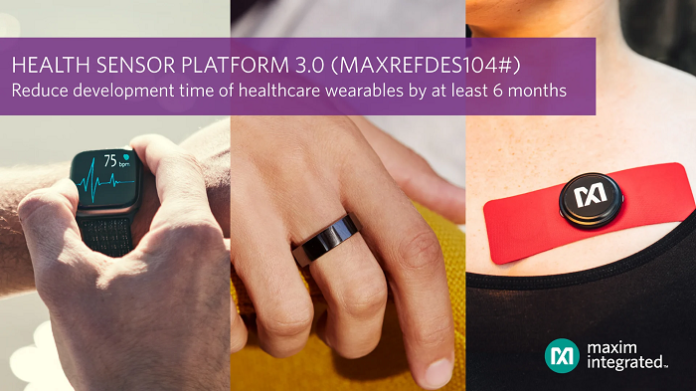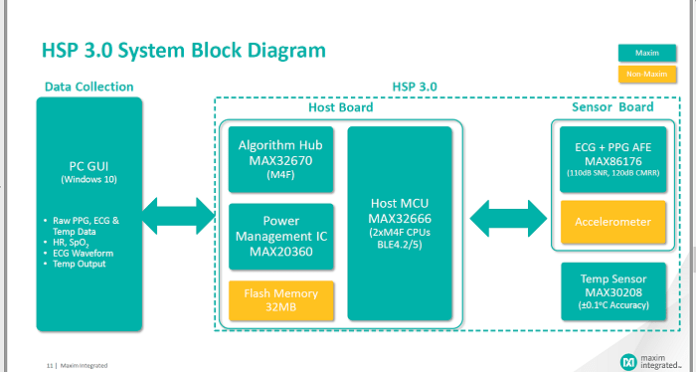Addressing the needs of advanced health wearable device designs that require multiple sensing measurements and high accuracy, Maxim Integrated Products, Inc. has released its third-generation of ready-to-wear, wrist form-factor wearables reference design. The Health Sensor Platform 3.0 (HSP 3.0) cuts the development time of medical wearables by at least six months compared to starting from scratch. The two most significant upgrades to the platform are the additions of the clinical-grade blood oxygen saturation (SpO2) measurement and dry-electrode capability to the electrocardiogram (ECG).
The HSP 3.0 offers a complete demonstration and development platform for developing healthcare wearables for remote patient monitoring (RPM). Integrating several sensors for new functionality, the HSP 3.0, or MAXREFDES104#, monitors SpO2, ECG, heart rate (HR), body temperature, and motion. It delivers upgrades across the board compared to the previous generation, opening up new medical use cases.
 The platform includes algorithms for HR, heart-rate variability (HRV), respiration rate (RR), SpO2, body temperature, sleep quality, and stress level information. It meets clinical-grade performance for SpO2, temperature, and ambulatory ECG (IEC 60601-2-47).
The platform includes algorithms for HR, heart-rate variability (HRV), respiration rate (RR), SpO2, body temperature, sleep quality, and stress level information. It meets clinical-grade performance for SpO2, temperature, and ambulatory ECG (IEC 60601-2-47).
The reference design allows wearable designers to start collecting data immediately, and it can be adapted for other dry electrode form factors such as chest patches, smart rings, and finger-based monitoring.
Maxim is focused on providing solutions in two key RPM areas: preventive and chronic disease management. “Preventive care is really about empowering the users or the patients, depending on what level they’re at, to take more control over their overall health and well-being,” said Andrew Baker, managing director for the Industrial and Healthcare Business Unit at Maxim Integrated.
“If an individual is predisposed or through generally poor lifestyle choices affected by a chronic disease, for example, COPD – chronic obstructive pulmonary disease – it’s about monitoring 24/7,” said Baker. “It’s about collecting a lot of data, looking for trends, and ultimately, the goal, in the case of COPD management, is to head off an exacerbation, getting to a condition where they need to be hospitalized.”
Everything is becoming more personalized and in a couple of different ways, he said. “Health-care providers are making health-care delivery more patient-centric but also individuals are becoming more and more responsible for their own health. The next-generation products are pushing the boundaries in terms of health-care measurement and enabling clinicians to gather that data to make an effective diagnosis or to manage that condition.”
In addition, the Covid-19 situation has reinforced the need for more remote connected health care to better serve the needs of individuals, he added.
The upgraded platform is designed to open up new uses cases for both medical and consumer wellness wearable applications and it can be implemented in other form factors other than just the wrist-based applications.
One use case cited for HSP 3.0 is what Maxim calls the virus pandemic model that demonstrates the key vital signs that could be measured in this type of RPM environment. The pandemic model has various stages of the virus. These stages include predictive screenings (temperature and SpO2) and onset monitoring of high-risk patients with underlying diseases (temperature, SpO2, HR/ECG, and respiration with periodic telemetry), which would indicate if somebody’s either sick or getting sick. Two other stages call for 24/7 telemetry that include post-hospital (temperature, SpO2, HR/ECG, and respiration) and deteriorating condition monitoring (temperature, SpO2, HR/ECG, and respiration).
Those individuals who contract Covid-19 would be candidates to be monitored very closely, but the overall idea of remote patient monitoring is to keep people out of the hospital, said Baker.
The upgrades
Compared to its predecessor, the Health Sensor Platform 2.0 (HSP 2.0), the HSP 3.0 adds an optical SpO2 measurement and dry-electrode capability to the ECG. This enables the medical devices to monitor cardiac heart and respiratory issues for management of ailments like COPD, infectious diseases (e.g. COVID-19), sleep apnea, and atrial fibrillation (AFib).
In addition, it comes with a narrower form factor and enhanced optical architecture, which improves signal acquisition quality, and includes an upgraded microcontroller, power, security, and sensing ICs. The reference design includes complete optical and electrode designs, along with algorithms to meet clinical requirements.
The HSP 3.0 offers a number of advantages, said Baker. “The biggest one is faster time to market. The estimation is still at least six months but it could be more and that’s achieved through proven interoperability of all the IC solutions as well as the algorithms and firmware, all working together in the device.”
However, the significant new feature is the SpO2 blood oxygen saturation measurement on the wrist for pulmonary function monitoring and sleep disorders, said Baker. This is clinical-grade and capable of achieving the FDA’s clinical standard and other regulatory bodies around the world, he added.
In addition, it also includes the latest clinical-grade temperature sensor and the ECG passes regulatory standards, IEC 60601-2-47, Baker said.

The system is comprised of two main boards plus a separate sensor board with a flex cable to add the temperature sensor.
The host board, comprised of the microcontrollers, power, memory, and algorithm hub, provides communication with the host, in this case a PC, and the main sensor board includes the latest AFE that integrates ECG and PPG (photoplethysmography) in a single chip, along with the optical heart-rate sensor and accelerometer. The temperature sensor on a flex cable [a separate sensor board] offers improved performance due to isolating it from the rest of the system compared to the HSP 2.0, Baker said.
One of the most significant devices in the platform is the new clinical-grade MAX86176 AFE that combines Maxim’s latest PPG technologies with an upgraded ECG block.
“It offers all of the advantages of our PPG AFEs including two-channel simultaneous acquisition. It allows people to synchronize the two channels even with independent sample rates,” said Baker. “The independent sample rates is quite a big deal because it’s the only device that really enables it. Typically, when you have two solutions in a single package they need to have the same sample rate, but in a system you need that flexibility to save power for certain types of use cases.”
An example of a new use case that could benefit from the power savings offered by the synchronization of PPG and ECG with independent sample rates is pulse arrival time (PAT). This is often used in cardiac uses cases for arterial health, but has also been experimented with as a proxy for blood pressure, said Baker. “The independent sample rates are important to save power as during ECG. You can have a lower sample rate on the PPG channel as it is low motion where you don’t need high sample rates.”
The new platform also implements active right leg drive (RLD) that is optimized for ECG dry electrode performance. It offers a best-in-class common-mode reduction ratio (CMMR) of >110 dB that optimizes performance as well as reduces noise.
“In addition, we can characterize the ECG electrodes through an impedance measurement for system level optimization and the high SNR (signal to noise ratio) of 110 dB helps the performance of the SPO2,” Baker said.
What’s on the boards
The HSP 3.0 includes the following sensor, power management, microcontroller and algorithm products:
- MAX86176: The low-noise optical PPG and electrical ECG AFE offers 110-dB SNR to add SpO2 saturation capability and over 110-dB CMRR for dry electrode ECG applications. The device enables synchronous acquisition of PPG and ECG measurements, even with independent sample rates, providing pulse transit time for cardiac health use cases.
- MAX20360: The highly integrated power and battery management power management IC (PMIC) is optimized for advanced body-worn health sensing devices. It includes Maxim Integrated’s high-accuracy ModelGauge m5 EZ fuel gauge, a sophisticated haptic driver, and a unique low-noise buck-boost converter that maximizes SNR and minimizes power used for optical bio-sensing.
- MAX32666: The Bluetooth (BLE)-enabled, ultra-low power microcontroller (MCU) with two Arm Cortex-M4F cores and an additional SmartDMA permits running the BLE stack independently, leaving the two main cores available for major tasks. The MCU integrates an entire security suite and error correcting code (ECC) on the memories to significantly increase the system’s robustness.
- MAX32670: The ultra-low-power MCU is dedicated to Maxim Integrated’s PPG algorithms of pulse rate, SpO2, HRV, RR, sleep quality monitoring, and stress monitoring. It can be configured either as a sensor hub to support firmware and algorithms or as an algorithm hub to support multiple algorithms. The MAX32670 seamlessly enables customer-desired sensor functionality, including managing the MAX86176 PPG and ECG sensor AFE as well as delivering either raw or calculated data to the outside world.
- MAX30208: The low-power, high-accuracy digital temperature sensor comes in a small package size of 2 x 2mm, claiming 33 percent lower operating current compared to the closest competitive solution. It reads the temperature on the top of the package and can be mounted on a flex cable or PCB, making it easier to design into wearables, said Maxim. With accuracy of 0.1°C, the MAX30208 meets clinical temperature requirements.
The HSP 3.0 (MAXREFDES104#) is available with hardware, firmware, and algorithms. It is priced at $400 and can be purchased at Maxim Integrated’s website.
Advertisement
Learn more about Maxim Integrated








